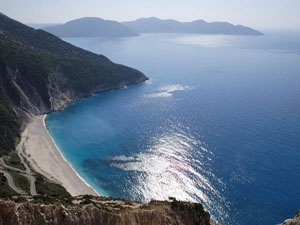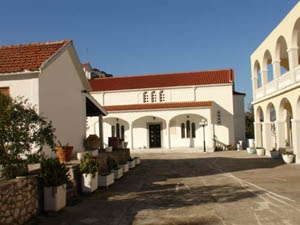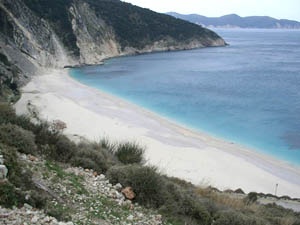|
The region of Pilaros in
northern Kefalonia could be said to justify its existence purely as
a setting for the enchanting beach of Myrtos.
However, the sheer beauty of its countryside, coupled with a long
and varied history, makes this area unique.
The birthplace of Marinos Antipas, this untamed and delightful area
stretches from the bay of Myrtos across to the shores of Agia Efimia,
nestling between the mountains Saint Dinati and Kalon Oros. |
|
View photos of the region
|
 |
Here are well-kept
villages, where time rolls by slowly in the traditional cafes of
another era, as well as designated Areas of Outstanding Natural
Beauty (NATURA).
One coastline faces the island of Ithaca, which can be seen equally
well from the beach at Agia Efimia as from higher up the
mountainside at the Monastery of Themata.
The opposite coastline looks out over the open sea as it vanishes
over the horizon, leaving behind the spectacular colors of the
waters at Myrtos.
Despite being in competition with the two beautiful coastlines, the
inland areas have much to offer the visitor.
|
|
The villages of
Drakopoulata, Antipata, Makriotika, Dendrinata - the “other” Pilaros-
are impressive as much for their natural beauty as for the part they
play in maintaining the traditions of the area.
|
|
|
| |
|
|
HISTORY |
The Municipality of
Pilaros is bordered by two mountains, Agia Dinati (1.131m) and Kalon
Oros (900m), and two shorelines, Agia Efimia to the east, and Myrtos
to the west. It lies 34 Km from the capital of the island, Argostoli.
Agia Efimia, the administrative headquarters of the municipality, is
just 9km from Sami, the main port of entry for the entire island.
Historicaly, Pilaros was (and still is) of particular importance,
beeing the passage through to the north of Kefalonia in ancient
times. The name Pilaros comes from the ancient word “piloros”,
meaning “the guard of the gate”.
During classical times, it was part of the city-state of Sami. The
remains of fortified towers in Agia Efimia and Drakopoulata testify
to the role of Pilaros in guarding the entrance and exit to its
fertile valley.
The medieval period was a time of change and reorganization, while
later during the Frankish Occupation and Venetian rule, populations
were moved around according to the various colonization policies and
the demands of the feudal system. This led to the creation of new
settlements.
During the period of British domination, the inhabitants of Pilaros
played a great part in the radical fight for union with Greece. The
locals also participated in the revolution of 1821, with supplies
beeing sent to the rebels in mainland Greece from the port of Agia
EFimia. Following the Union of the Ionian Islands with Greece
(1864), Pilaros played an important role in the political, social
and economic development of Kefalonia, while many people from this
area have distinguished themselves in recent history. One of the
most notable of these was Marinos Antipas (1872-1907), with his
unarguably significant contribution to the spread of the first
socialist ideas in Kefalonia, and in promoting the agricultural
movement in Thessaly.
At the end of the 19th century and at the beginning of the 20th,
many local inhabitants turned to the sea while Agia Efimia became a
trading centre. A large proportion of the population was engaged in
agriculture and cattle-farming. Cheese-makers from Pilaros earned a
name for themselves not only in Greece, but also as far afield as
the Balkans and southern Italy.
The Second World War and the Italian-German occupation, along with
the 1953 earthquakes, dealt a hard blow to the development and
growth of the region as these events were followed by mass
emigration.
Over the last few decades, Pilaros has entered into the new phase of
social and economic growth that has characterized Kefalonia as a
whole.
ARCHAEOLOGICAL SITES
The importance of Pilaros in ancient times for northern Kefalonia
has been proved indisputably by the existence of the fortified
towers at the two opposite ends of the valley. Just outside the town
of Agia Efimia, the ruins at Palatia are particularly impressive;
between the enormous stones of the walls there are stunning views of
the valley and the eastern coastline.
There is also a mosaic floor belonging to a Roman villa in
Arhaiotiton Street in Agia Efimia.
Throughout the region of Pilaros there are well-preserved,
pre-earthquake buildings of great architectural and aesthetic value. |
|
SIGHTS |
|
|

|
ΙTHE MONASTERY OF THE HOLY
VIRGIN MARY, THEMATA
The Monastery was built at the end of the 10th century and is
located on the mountainside of Agia Dinati, among an enchanting
forest of ancient holm oak trees, known as “Pournarodasos”. The
views from the Monastery are spectacular, as it is a wonderful
vantage point for seeing both Ithaca and the Ionian Sea.
The old carved wooden icon-screen is kept in the church, along with
many old icons. The most important of these, is “The Virgin Mary of
Themata”, which is carried in procession the Tuesday after Easter
when a hugely popular festival is held in nearby Pournarodasos.
|
|
The Monastery of Themata
can be reached along a wide tarmac road that enables the visitor to
stop on the way up to admire the amazing views.
The church of Agia Efimia in the town itself is an important place
of worship in Pilaros. Each year on 11th July Saint Efimia is
commemorated with a procession of the icon and one of the most
popular and well-attended festivals on the island.
There are many churches of remarkable cultural and architectural
value in Pilaros. Among these are: the Monastery of Anatolikou (or
“Antelikou” as the locals call it), which is dedicated to the
Assumption of the Virgin Mary; the church of Hypapanti; and the
church in Sia. The Monastery of Anatolikou was built in 1194 and the
church you can see today is one of the few buildings in the area to
have survived the 1953 earthquakes.
|
|
VILLAGES
Pilaros is full of picturesque villages of varying sizes, each one
with its very own local-colour and history.
The traditional village of Drakopoulata is of particular interest
with its many exceptional pre-earthquake houses. Makriotika is the
largest village in the area and has wonderful views of the valley
and sea. In Potamianata, next to the statue of Marinos Antipas, you
can see a pre-earthquake windmill, which is one of the many mills
that existed in the region in the past.
The remains of the 33-metre-high bell-tower of Sotiras are located
in Ferentinata, while in Dendrinata there is an old, carved, wooden
icon-screen of great value in the church of Saint Konstantinos.
Divarata, above Myrtos beach, lines the road that leads to Erissos,
and offers fine accommodation and traditional tavernas.
Each village boasts quaint, traditional architecture alongside
modern facilities, all built of "Falari" stone. That's why a tour
around the inland areas of Pilaros offers just as many pleasant
surprises as the coastlines.
|
| |
|

|
BEACHES
You will never have seen a beach more lovely than Myrtos.
If a picture is worth a thousand words then a picture of this
particular beach, with its blue-green waters, is worth a whole
volume of words.
But Myrtos is more than a picture, even if it has been the island's
"trademark" for many years now.
|
ΤIt is a beach that you
have to see for yourself to get a true understanding of what it is
really like.
What is Myrtos exactly? It is a sea of infinite blues and turquoises
that defy description, vying for supremacy with the rocky coasts of
western Pilaros and the dazzling 800m-shore of white sand and
pebbles.
Your first sight of Myrtos from the road above literally takes your
breath away. The road down to the beach passes through a lush
ravine, allowing you frequent glimpses of the beauty that awaits
you.
Have a swim in the crystal clear waters, or lounge on the
sun-drenched beach.
Myrtos has been awarded the Blue Flag for many years now. In
2003-2004, it won the title of Best Beach in an international
competition on the website
www.thalassa.gr .
|
|
The beauty of the beaches
of Pilaros doesn't end with Myrtos, however.
The clear waters of the beach at Agia Efimia offer an alternative
for those who wish to have swimming and playing in the waves and the
sun.
In an area called Giros, along the coast from Agia Efimia,
sun-lovers find their own paradise in the crystal clear waters of
the white sandy beaches along the rocky coastline.
Along the whole length of the road leading from Agia Efimia to Sami,
right next to the road itself, are "gems" of beaches; innumerable
small sandy beaches with completely transparent water, hidden among
the rocks which are a feature of this coastline, which allow the
visitor to enjoy swimming from his own “private” beach. The flat
stones along the coast are ideal for diving and sunbathing.
There are also many bays accessible only from the sea, which are
excellent for swimming and diving.
A Diving School in Agia Efimia offers courses and organizes
occasional group diving trips in the area.
|
|
ENVIRONMENT
Mount Kalon has been designated as a NATURA Region (code number
GR2220001) according to a directive from the European Union NATURE
2000 programme, which aims to built up a register of "ecological
paradises".
The area covers a total of 2.566 hectares and is considered an
important ecological site because of the variety of Mediterranean
species found there.
The vegetation consists mainly of plants such as lentisks, holm oak
and arbutus, while in some regions a deep red species of peony can
be found, as well as entire meadows of various orchids and a wide
variety of wild flowers.
Mount Kalon has also been recognized as an important conservation
area for the bird populations of Greece.
A great deal of cattle-farming went on here in previous centuries,
and Mount Kalon is home to many stone cottages of a style peculiar
to the region.
Environmental preservation and conservation are of immense
importance in Pilaros, which is an area of great natural beauty.
The wind farms, both on Mount Agia Dinati and in Imerovigli on the
border between the Municipality of Pilaros and the Municipality of
Argostoli, show the great strides made in the development and use of
alternative sources of energy.
The Voluntary Environmental Team for the Protection of the
Environment of Pilaros is involved in forest conservation during the
summer, as well as taking part in activities such as tree-planting
and the cleaning up of beaches and public areas.
|
|